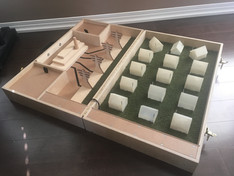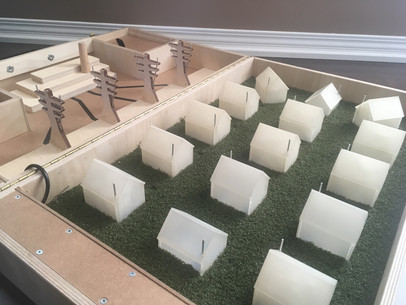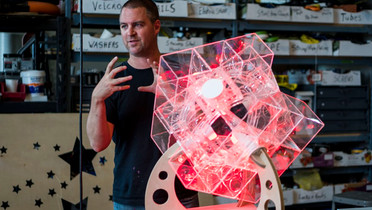Cloud Cannon
A leftover barrel with a rubber membrane on one side and a hole on the other.
A fog machine is stored below and piped into the barrel. Hitting the membrane creates smoke rings that can travel up to 100 feet. I designed a gimbal made of plywood for the barrel to sit on so that the cannon can be aimed up/down/left/right. The rolling cabinet has integrated stairs so
kids of various sizes can use it.

CKM Tunnel
Strips of leftover countertop laminate held together with orange zip-ties. End caps are CNC milled particleboard. The tunnel was used for small children in our “Material of
the Season: Cloth” program. Over the course of several months, kids tied bits of cloth onto the tunnel until it the walls gradually became opaque.

Wire the Neighborhood Case
Plywood, MDF, acrylic, Arduino. We have a permanent exhibit called Wire the Neighborhood which is a puzzle demonstrating the complexity of electrical distribution, and the reason for brownouts. Our outreach program asked for a mobile version of this exhibit that they could take around to local schools. I designed and built both the physical and electrical parts of this exhibit. We did not have access to the code which ran the permanent exhibit, so I wrote new Arduino code from scratch.

Snow Globe
Plywood, poly sheet, blower, LED strips, biodegradable packing peanuts. This was
the centerpiece and photo op for our Christmas program in 2017. Most of the pieces were CNC milled. The finial on top was made of laminated plywood and turned by hand.

Workshop
Plywood, MDF. Sometimes the rough, maker aesthetic goes too far. We had a permanent kids’ workshop space that was contained by sawhorses covered with cardboard and cardboard tubes held together with zip-ties (see photo). I designed a new workshop wall that had sweeping curves, storage space, counter space, and less tendency to fall over.

HoverCraft
Plywood, inner tubes, and leaf-blowers. We had existing hovercrafts which were a
circle of plywood and a single leaf blower. They didn’t work well because if the rider wasn’t perfectly balanced one side would drag and the air would escape out the other. I designed a 3-pod hovercraft so that regardless of the load balance on the seat, the individual pods would still
have perfectly centered loads.

Tight Rope
Laser-cut acrylic. This was a pilot design for a “tightrope unicycle” I wanted to build
for one of our galleries. We had a DC gear-motor lying around, so we stretched a couple of steel cables and hooked them up to a bench-top power supply to test the concept. The final piece did not end up getting built.

Enterprise
Laser-cut cardboard. We hosted a traveling Star Trek exhibit, during which we also had a program called “Cardboard City” where visitors built things out of cardboard. I decided to design a cardboard Enterprise to tie the two together.

Trophy
Laser-cut acrylic, plywood, dichroic film. This was a series of awards I designed and built for our outgoing board members. The design mimics an entry feature of rotating rings which is seen as cars pull into our parking lot. Once again, the “maker” aesthetic; the wood is sealed but meant to look unfinished. Names and designs are laser etched in the acrylic.

Slingshot
A barrel filled with gravel, plywood, and a slingshot made of surgical tubing. One of
the shop techs made a rough slingshot using 2x4s. It was a huge hit, launching plush toys across our atrium, but it needed to look better and be more mobile. I’m happy with the physical design I came up with, but not the random, garish color scheme.





























